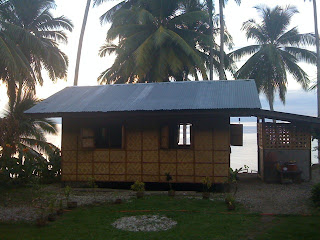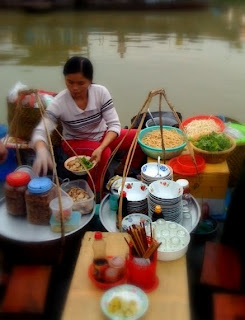Dear Readers,
I finally have the chance to catch up on some blogging. Derek and I have been outside of China for the last month traveling in the Philippines, Cambodia and now Vietnam. I have had a lot of blog topic ideas in my head but somehow the time has just slipped by and next week we’ll be headed back to Nanjing where I will be thrown into a busy, hectic schedule again.
Anyway, while I have a little break in our hectic travel schedule, I thought I would first recap our trip to Philippines. The Philippines holds a special place in my heart and within my family’s history. From 1984-1989, my family lived in Manila- five influential years of my childhood and early adolescence. Before that, my parents were Peace Corps volunteers there in the early years of the program from 1965-1967. Bill, my stepfather, also lived with his family in the early 1960’s in Manila. Finally, my great-grandfather, Julius Jenss, sought adventure in Dagupan, Philippines selling slot machines in the early 1900’s in the years following the Spanish American War and the beginning of a new era of foreign influence in the Philippines.
Given my extended family history in the Philippines, it was pretty uncanny when Derek came into my life and on our first date, told me that his own father lives in the Philippines. So, it’s meant to be- the Philippines and its draw to me and my family. What has now permanently strengthened my ties with the Philippines is that Derek (and I through him) now has an extended Filipino family. On this trip down to the Philippines, we spent some time with Derek’s father Doug and also got to meet his wife Rowena and their children Angel, Faith, Derrick, Charlene and Simon. Derek’s brothers and sisters took to him very quickly and affectionately called him Kuya or “big brother” in Visayan, which they spoke along with English at home. I too have been dubbed “Auntie Steph”, which I enjoy.
For me revisiting the Philippines was also made unique by the opportunity to spend time with a Filipino family. My childhood years in Manila gave me the opportunity to meet Filipino friends as well as friends from all over the globe. However meeting Rowena’s family was the first time I really got to spend extensive time with a Filipino family and therefore learn about the important role that family plays there. What I have experienced in the US is that many children move out of home once they come of age and then only see extended family during major holidays. However, in the Philippines, it seems that many children continue to live close to their family even after they have grown up. It’s not uncommon for grown-up sisters, brothers, and even cousins to live under one roof where they may help each other out with raising each others’ children, housekeeping, cooking, etc. In a Filipino family, children therefore grow up with a large but close-knit family. This was interesting for me to see first-hand with Doug and Rowena’s family. Admittedly I am a person who needs her own time and space sometimes and would have to adjust to living under such close quarters. Nevertheless, I do relish the few times in the year when I do see my parents, sisters and grandmother as well as extended family with all my cousins and wish that spending time with them wasn’t always squished into a one week period within a year or two. Communities with strong, close-knit families like in the Philippines have their merits for sure.
In addition to meeting our Filipino family, here are some of my favorite experiences in the Philippines (not in any particular order of favorite):
 |
| Jeepney |
Riding in a jeepney and tricycle: Jeepneys are extended jeeps that the Filipinos cleverly modeled from jeeps left by American GIs in WWII. They are probably the most widely-used mode of transportation in the Philippines. Jeepneys are family owned and operated and drive along a certain route. The destinations are penned on the side of the jeepney as well as on signs on the front dashboard. Passengers enter the jeepney in the back and then sit on a long seat along the length of the jeepney facing passengers on the opposite side. A ride in Manila was only 7 Pesons, about $.20 and payment is handed up by passengers in the back to the driver in the front. Another common mode of transportation are tricycles- motorbikes with extra seats you can hop onto and tell the driver where you want to go. Sometimes you’ll have to share the ride with someone else.
 |
| Derek riding in a jeepney in Manila |
 |
| Tricycles and busy streets in Tagum |
 |
| Bangka boat |
Bangka boats, nipa huts, disappearing islands, and snorkeling: Need I say more? Beautiful white sand beaches, untouched coral reefs with bright blue star-fish and an array of tropical fish. And to top it off, how about some freshly cracked coconut juice picked from the tree five minutes before while you were out snorkeling?
 |
| Nipa hut |
 |
| Polvoron |
Polvoron, calamansi juice and Chippy: My favorite Filipino snacks and junkfood. Polvoron is powdered milk candy. Sounds strange but yummy!
Karaoke singing at home or by the pool: The experience is made even better by the wide selection of cheesy 80’s music that seems to be embraced with such fervor in the Philippines.
 |
| Kuya Derek signing the Gambler. |
Filipino communication skills 101: Here is a lesson on communicating with a Pinoy. If someone asks you a question and you want to respond affirmatively “yes”, simply look at that person and raise your eyebrows once. If someone asks you where something is, simply point in the direction of said object with your lips. If you would like to get someone’s attention, simply make a very slight hissing sound.
Lovely people: Besides the beautiful beaches, I think the Philippines biggest draw is in fact the Filipino people. Getting around is not a problem because English is so widely spoken. People are warm, gracious, friendly and are always happy to show you Filipino hospitality.

 countries) wanting to do business in Asia. Indeed, many international companies are starting to close shop in China and are moving South to open factories and plants in Vietnam. Tourism has also boomed in recent years too. Some people we met said that before 1993, Vietnam was very much closed off the rest of the world, but over the years, more and more tourists have made Vietnam their destination in Asia. No longer is Vietnam a destination you can go as a tourist and be a loner. Most of the tourists I saw were from Australia, a now short plane ride away from Down-Under and an affordable vacation trip for a week. Nevertheless, we did not seem to encounter many other Americans and when people learned of where we were from, they did not react negatively. Maybe it’s because we had some Kiwi companions or because the war was long enough ago that most people have put it behind them.
countries) wanting to do business in Asia. Indeed, many international companies are starting to close shop in China and are moving South to open factories and plants in Vietnam. Tourism has also boomed in recent years too. Some people we met said that before 1993, Vietnam was very much closed off the rest of the world, but over the years, more and more tourists have made Vietnam their destination in Asia. No longer is Vietnam a destination you can go as a tourist and be a loner. Most of the tourists I saw were from Australia, a now short plane ride away from Down-Under and an affordable vacation trip for a week. Nevertheless, we did not seem to encounter many other Americans and when people learned of where we were from, they did not react negatively. Maybe it’s because we had some Kiwi companions or because the war was long enough ago that most people have put it behind them. 
![]()













